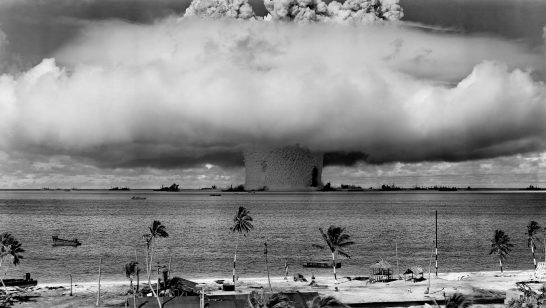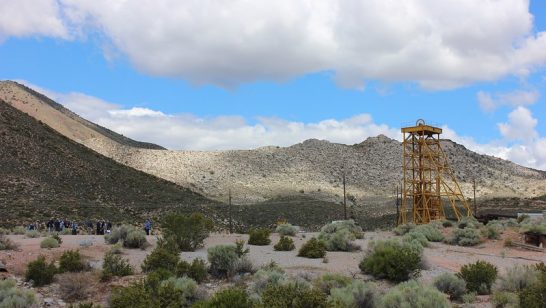
On Saturday 29th August 2020, the international community commemorates the tenth International Day against Nuclear Tests. This year, the day is overshadowed by reports that the Donald Trump administration is considering the resumption of nuclear testing as a bargaining chip to lure Beijing and Moscow into trilateral arms control negotiations. Last year, rumours circulated that then-national security advisor John Bolton was urging President Trump to ‘unsign’ the Comprehensive Nuclear-Test-Ban Treaty (CTBT).
The upcoming Nuclear Non-Proliferation Treaty (NPT) review conference presents an important opportunity to raise the profile of the CTBT. States parties to the CTBT should redouble their commitment to the international norm against testing by giving special attention to the challenge of the treaty’s entry-into-force.
The adverse impact of nuclear testing
Since the first nuclear test explosion at Alamogordo, New Mexico on 16 July 1945, over 2,000 nuclear tests have taken place. States conduct nuclear tests to gather ‘information on how well nuclear weapons work, how they behave under various conditions and how adjacent structures react to nuclear explosions’. By conducting a nuclear test explosion, some states also wish to make ‘a political statement of national, scientific and military pre-eminence’.
But these 2,000 tests have had an adverse geostrategic, environmental and humanitarian impact.
Nuclear tests cause geostrategic volatility. For example, North Korea’s sixth nuclear test on 3rd September 2017 increased tensions with the United States, prompting President Trump to warn of ‘a massive military response’ if Pyongyang threatened Washington with nuclear war. The sabre-rattling culminated on 3rd January 2018 in President Trump’s tweet that his nuclear button ‘is a much bigger and more powerful one than his [North Korean leader Kim Jong-un], and my Button works!’.
Nuclear tests also empower nuclear arms races. Before the CTBT opened for signature in September 1996, over 2,000 tests took place (of which the United States carried out 1,032 and the Soviet Union/Russia 715). However, since the CTBT enshrined the international norm against nuclear testing, only ten tests have been conducted (two by India in 1998; two by Pakistan in 1998 and six by North Korea between 2006 and 2017). A CTBT in force would make it more difficult to re-start a spiralling nuclear arms race.
The cessation of nuclear tests was also a pivotal factor in the indefinite extension of the Nuclear Non-Proliferation Treaty (NPT) in 1995, meaning that many ‘non-nuclear-weapon states will perceive a return to explosive nuclear testing as a violation of the NPT bargain’.
The adverse impact of nuclear testing is not limited to geostrategy, however. The 2000 Report of the United Nations Scientific Committee on the Effects of Atomic Radiation to the General Assembly noted that ‘The main man-made contribution to the exposure of the world’s population [to radiation] has come from the testing of nuclear weapons in the atmosphere, from 1945 to 1980. Each nuclear test resulted in unrestrained release into the environment of substantial quantities of radioactive materials, which were widely dispersed in the atmosphere and deposited everywhere on the Earth’s surface’.
While the Partial Test Ban Treaty (PTBT) has outlawed atmospheric, outer space and underwater nuclear tests, underground nuclear testing has not eradicated the environmental and humanitarian impact of nuclear testing.
Underground radiation can pollute groundwater when testing in water-saturated rock. The Nevada test site, for example, has ‘a high risk of groundwater contamination with several radioactive isotopes’.
A second environmental risk from underground tests is venting; that is, the accidental release of radionuclides into the atmosphere. Of roughly 800 underground tests conducted at the Nevada site, there have been ‘at least’ 32 identified instances of venting, resulting in the release of ‘considerable quantities of radionuclide 131I’ (Iodine-131).
A third environmental risk are earthquakes offset by nuclear tests. North Korea’s 2017 underground nuclear test was the likely cause of a 6.3 magnitude earthquake that was felt as far away as Vladivostok.
The humanitarian impact of nuclear testing results from radiation exposure, which is a likely cause of leukaemia, thyroid, breast and lung cancer.
The importance of CTBT entry-into-force
The only path to halting the adverse impact of nuclear testing is by achieving the entry-into-force of the CTBT. Once in force, the CTBT will represent a legally binding barrier against nuclear testing.
Although the treaty has achieved near-universality, with 184 signatures and 168 ratifications, the treaty can only enter-into-force after all 44 states listed in Annex II to the CTBT deposit their instruments of ratification. Eight Annex II states have yet to ratify for the CTBT to enter-into-force; of the eight remaining states, China, Egypt, Iran, Israel and the United States have all signed, whereas North Korea, India and Pakistan have neither signed nor ratified at the time of writing.
Given that President Trump has not only ruled out ratification of the CTBT in the 2018 US Nuclear Posture Review but also considered the resumption of nuclear testing, the international community should redouble its efforts to strengthen the norm against testing. The ELN outlined specific measures to this end in a 2019 policy brief.
These include raising the profile of the CTBT in the next NPT review conference to highlight the importance of non-testing for the global non-proliferation regime. States parties should also engage the remaining non-signatory and non-ratifying states to make progress on CTBT universalisation, especially among non-Annex II states, to sustain the normative pressure against nuclear testing. Coordinated unilateral declarations could be sought from the remaining non-signatories and non-ratifying states to re-consider their stance on the treaty. Non-signatories should become accredited observer states to the CTBT Organisation’s plenary body, the Preparatory Commission. Finally, states parties should maintain funding for the CTBTO to ensure the operational capacity of the international monitoring system.
The opinions articulated above represent the views of the author(s) and do not necessarily reflect the position of the European Leadership Network or any of its members. The ELN’s aim is to encourage debates that will help develop Europe’s capacity to address the pressing foreign, defence, and security policy challenges of our time.
Image: Wikimedia Commons, Signing of the Nuclear Test Ban Treaty



